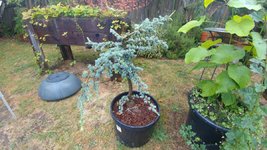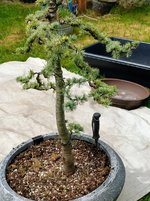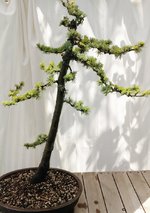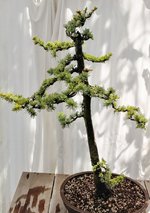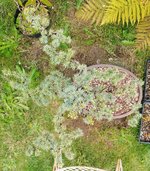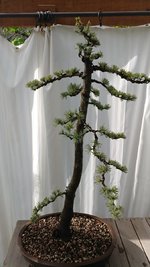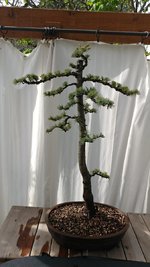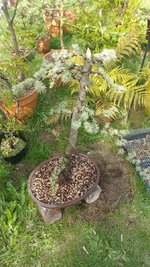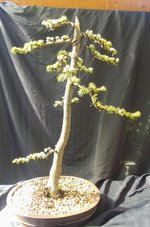Ok... this is an Atlas Cedar. There’s some things you ought to know about them, because they are a little more difficult in some ways. (And easy in others!)
Their branches (wood) is very sappy and springy. You have to use really strong wire to be effective, because over time, they will revert back to the way they were. And the wire needs to stay on for a long time. And when you remove the wire, the branch will move back, and you’ll have to rewire it.
They DO back bud well wherever there’s foliage. They don’t back bud on old wood very well. Make sure when you cut back, there’s an active bud. BUT... cutting back WILL encourage back budding, and you can develop nice pads. It’s important to keep foliage close to the trunk, so cutting back will encourage the tree to grow close in branches, and not get “leggy”.
Now, when I look at your tree, I see you have wired with aluminum, which I strongly discourage for Atlas Cedar. The branches have enough spring in them to overpower aluminum. One of the things about using copper wire is that usually you can use thinner Copper than you would with aluminum. But Atlas Cedar is so springy, you should use heavy copper wire! Really.
See how your branches arch? You don’t want that. Assuming you want the branches to hang down, they should start moving down directly from the trunk. You say you couldn’t do that? Well, it’s because the wire wasn’t strong enough. Even using copper, you might need something extra. Take a look at the following diagram:

Look at Fig.16. A piece of rebar was tied to the bottom of the branch. Pad with rubber. The end of the rebar closest to the trunk is about 1/4 to 1/2 inch away from the trunk to give it room when it’s bent down. Then the branch is pulled down using the rebar. The guy wire holds it in place. What this does is use the length of the rebar as leverage, but puts all the bend right at the place where the branch joins the trunk. No arching. That rig will have to stay in place a couple of years. There might be some minor tearing of the tissue on the top of the joint. Put cut paste on. It will heal.
I hope this helps. Atlas cedars are more difficult to wire effectively than other conifers. They require heavier, stronger wire, and it takes more time to “set”. And count on having to remove and replace the wire every two years! Once you get the structure set up, then they are easy to maintain and develop ramification.
Good luck!
 Got it wired in and potted up. I did the styling before the repot but forgot to take pics. Watered in well with a little Superthrive, I know it's controversial but I've always used it at repot and have good results, could just be my aftercare but I stick with what works for me. So starts it's bonsai journey.
Got it wired in and potted up. I did the styling before the repot but forgot to take pics. Watered in well with a little Superthrive, I know it's controversial but I've always used it at repot and have good results, could just be my aftercare but I stick with what works for me. So starts it's bonsai journey.